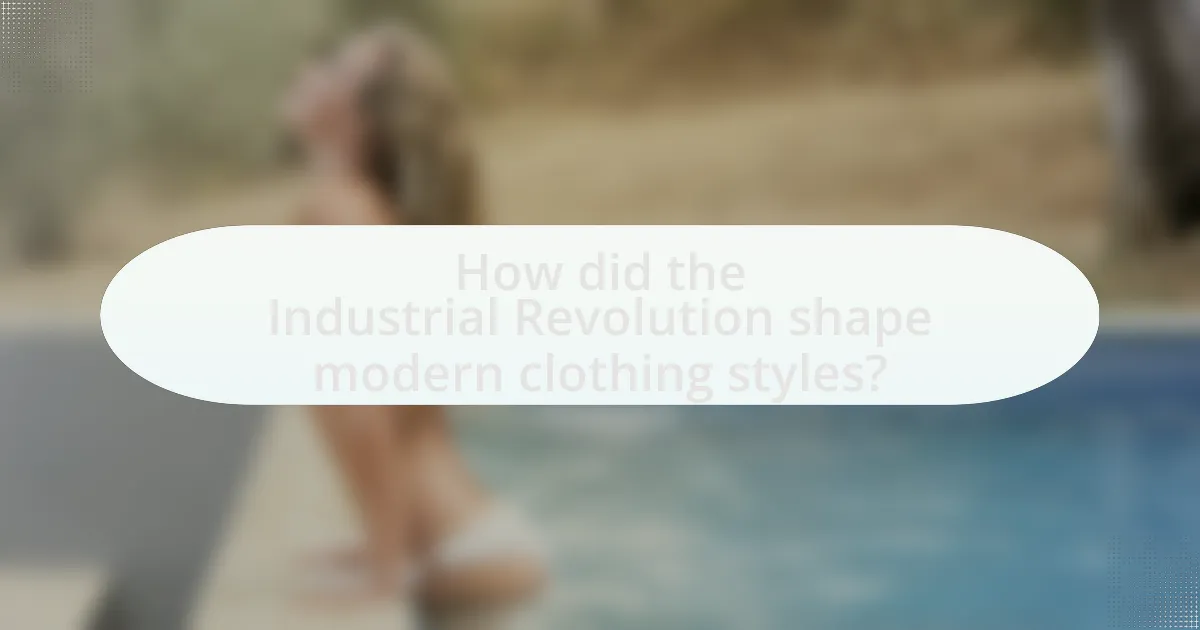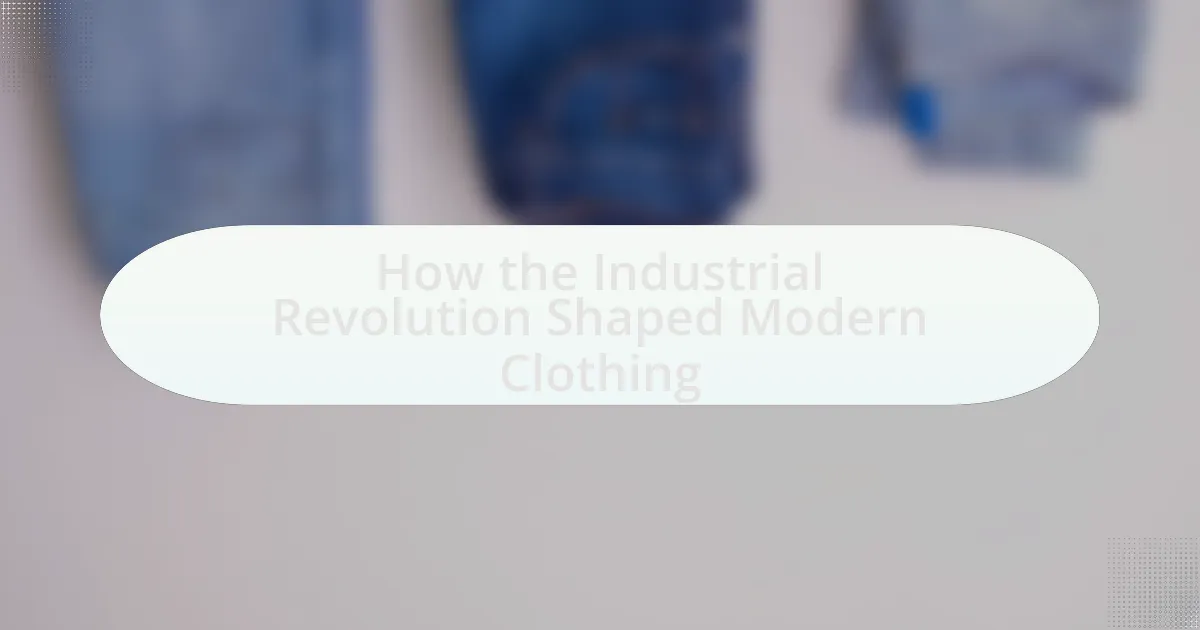The Industrial Revolution fundamentally transformed clothing production through mechanization and mass production techniques, leading to the rapid manufacturing of textiles and garments. Key technological advancements, such as the steam engine, spinning jenny, and power loom, significantly increased efficiency and reduced costs, making clothing more accessible to the general population. This period also saw the emergence of the ready-to-wear clothing industry, standard sizing, and the factory system, which reshaped consumer culture and fashion trends. Additionally, the environmental impacts of industrial clothing production and the subsequent rise of sustainable fashion movements highlight the ongoing relevance of these historical changes in today’s clothing industry.

How did the Industrial Revolution influence clothing production?
The Industrial Revolution significantly transformed clothing production by introducing mechanization and mass production techniques. This shift allowed for the rapid manufacturing of textiles and garments, drastically reducing production time and costs. For instance, the invention of the spinning jenny in 1764 and the power loom in the early 19th century enabled factories to produce fabric at unprecedented rates, leading to the availability of affordable clothing for a broader population. By the mid-19th century, the ready-to-wear clothing industry emerged, further revolutionizing how clothing was designed, produced, and consumed, making fashion accessible to the masses.
What were the key technological advancements during the Industrial Revolution?
The key technological advancements during the Industrial Revolution included the steam engine, the spinning jenny, and the power loom. The steam engine, developed by James Watt in the late 18th century, revolutionized transportation and manufacturing by providing a reliable power source. The spinning jenny, invented by James Hargreaves in 1764, significantly increased the efficiency of textile production by allowing one worker to spin multiple spools of thread simultaneously. The power loom, introduced by Edmund Cartwright in 1785, automated the weaving process, further enhancing textile manufacturing productivity. These innovations collectively transformed the clothing industry, leading to mass production and the rise of ready-to-wear garments.
How did the steam engine impact textile manufacturing?
The steam engine revolutionized textile manufacturing by significantly increasing production speed and efficiency. Prior to its introduction, textile production relied heavily on manual labor and water power, which limited output. The steam engine enabled factories to operate machinery at a much faster rate, leading to the mass production of textiles. For instance, by the early 19th century, steam-powered looms could produce fabric at a rate that was several times faster than hand-operated looms, drastically reducing the time and cost of textile production. This shift not only enhanced productivity but also facilitated the growth of the textile industry, contributing to the overall economic expansion during the Industrial Revolution.
What role did the spinning jenny play in clothing production?
The spinning jenny significantly increased the efficiency of clothing production by allowing a single worker to spin multiple spools of thread simultaneously. Invented by James Hargreaves in 1764, this multi-spindle spinning frame revolutionized the textile industry, enabling faster production of yarn, which was essential for weaving fabric. The introduction of the spinning jenny contributed to the shift from hand production methods to mechanized processes during the Industrial Revolution, leading to a dramatic increase in textile output and a reduction in labor costs. This innovation laid the groundwork for the mass production of clothing, fundamentally transforming the fashion industry and making textiles more accessible to the general population.
How did mass production change the clothing industry?
Mass production revolutionized the clothing industry by enabling the rapid and efficient manufacturing of garments on a large scale. This shift allowed for standardized sizing and designs, significantly reducing production costs and time. For instance, the introduction of the sewing machine in the mid-19th century facilitated the mass production process, leading to the establishment of factories that could produce thousands of garments daily. As a result, clothing became more affordable and accessible to the general public, transforming fashion from a luxury for the wealthy into a commodity for the masses. By the early 20th century, companies like Levi Strauss & Co. exemplified this change, producing denim jeans in large quantities, which became a staple in everyday wear.
What is the significance of the factory system in clothing manufacturing?
The factory system is significant in clothing manufacturing because it revolutionized production efficiency and scalability. By centralizing labor and machinery, factories enabled mass production of garments, drastically reducing the time and cost associated with clothing manufacturing. For instance, the introduction of the power loom in the early 19th century allowed for the rapid weaving of fabric, which increased output and lowered prices, making clothing more accessible to the general population. This shift not only transformed the economic landscape of the textile industry but also contributed to the rise of consumer culture during the Industrial Revolution, as more affordable clothing became available to a broader audience.
How did standard sizing emerge from mass production techniques?
Standard sizing emerged from mass production techniques as manufacturers sought efficiency and uniformity in clothing production. The Industrial Revolution introduced mechanized processes that allowed for the rapid creation of garments, leading to the need for standardized measurements to streamline production and reduce costs. By the late 19th century, companies began to adopt size charts based on average body measurements, which facilitated mass production and distribution. This shift was further supported by the rise of ready-to-wear clothing, which required consistent sizing to appeal to a broader market. The implementation of standard sizing not only optimized manufacturing but also transformed consumer expectations, establishing a framework for modern clothing retail.

What social changes accompanied the Industrial Revolution in relation to clothing?
The Industrial Revolution led to significant social changes in relation to clothing, primarily through the rise of mass production and the shift from handmade to machine-made garments. This transition allowed for the rapid production of clothing at lower costs, making fashion more accessible to the working and middle classes. The introduction of factories centralized clothing production, which altered traditional artisan roles and contributed to urbanization as people moved to cities for factory jobs. Additionally, the availability of diverse fabrics and styles reflected changing social norms, as clothing became a means of expressing individual identity and social status. The widespread use of textiles like cotton, facilitated by innovations such as the spinning jenny and power loom, further transformed clothing consumption patterns, leading to a culture of consumerism that characterized modern society.
How did urbanization affect clothing consumption patterns?
Urbanization significantly increased clothing consumption patterns by creating a demand for mass-produced garments. As populations moved to cities during the Industrial Revolution, the rise of factories enabled the production of clothing at unprecedented scales, leading to lower prices and greater accessibility. This shift resulted in a transition from handmade, bespoke clothing to ready-to-wear items, as evidenced by the establishment of department stores in urban centers, which catered to a growing consumer base. Additionally, urban lifestyles encouraged frequent clothing changes, reflecting social status and fashion trends, further driving consumption.
What impact did the rise of the working class have on fashion trends?
The rise of the working class significantly influenced fashion trends by promoting practicality and affordability in clothing. As industrialization progressed, the working class sought durable and functional attire suitable for labor-intensive jobs, leading to the popularity of simpler designs and mass-produced garments. This shift resulted in the decline of elaborate, aristocratic styles and the emergence of ready-to-wear clothing, which became accessible to a broader audience. The introduction of sewing machines and textile manufacturing innovations further facilitated this change, allowing for quicker production and lower costs, thus reshaping the fashion landscape to reflect the needs and realities of the working population.
How did women’s roles in society influence clothing styles during this period?
Women’s roles in society during the Industrial Revolution significantly influenced clothing styles by shifting from elaborate, restrictive garments to more practical and functional attire. As women increasingly entered the workforce, particularly in factories, their clothing needed to accommodate physical labor, leading to the adoption of simpler designs, such as the shift dress and bloomers, which allowed for greater mobility. This change was further reinforced by the rise of ready-to-wear clothing, which made practical styles more accessible. Historical evidence shows that by the late 19th century, women’s fashion reflected their evolving societal roles, moving towards garments that emphasized comfort and utility over ornamentation, aligning with their growing independence and participation in public life.
What were the environmental impacts of industrial clothing production?
The environmental impacts of industrial clothing production include significant pollution, resource depletion, and waste generation. Industrial processes in clothing manufacturing often release toxic chemicals into waterways, contributing to water pollution; for instance, dyeing processes can discharge harmful substances like azo dyes, which are known to be carcinogenic. Additionally, the production of synthetic fibers, such as polyester, relies heavily on petroleum, leading to resource depletion and increased carbon emissions. The fast fashion model, a product of industrial clothing production, generates massive amounts of textile waste, with an estimated 92 million tons of textiles discarded globally each year. These factors collectively illustrate the detrimental effects of industrial clothing production on the environment.
How did pollution from factories affect communities?
Pollution from factories significantly harmed communities by degrading air and water quality, leading to health issues among residents. For instance, studies have shown that industrial emissions contributed to respiratory diseases and other health problems in nearby populations. In the late 19th and early 20th centuries, cities like London and Manchester experienced severe smog and contaminated waterways due to factory discharges, resulting in increased mortality rates and public health crises. This environmental degradation not only affected individual health but also strained local healthcare systems and reduced overall quality of life in these communities.
What were the consequences of resource depletion in textile manufacturing?
Resource depletion in textile manufacturing led to significant environmental degradation and economic challenges. The extraction of raw materials, such as cotton and wool, resulted in soil degradation, loss of biodiversity, and increased pollution from chemical runoff. For instance, the overuse of water resources for cotton farming has been documented to cause severe water scarcity in regions like Central Asia, where the Aral Sea has drastically shrunk due to irrigation practices. Economically, resource depletion has driven up costs for manufacturers, leading to increased prices for consumers and a shift towards synthetic fibers, which further impacts environmental sustainability.

How did the Industrial Revolution shape modern clothing styles?
The Industrial Revolution significantly shaped modern clothing styles by introducing mass production techniques and new materials. This period, spanning from the late 18th to the early 19th century, saw the invention of machinery such as the spinning jenny and power loom, which allowed for the rapid production of textiles. Consequently, clothing became more affordable and accessible to a broader population, leading to the rise of ready-to-wear garments. Additionally, the introduction of synthetic dyes and fabrics expanded the variety and vibrancy of clothing options, influencing fashion trends. The shift from handmade to machine-made clothing established the foundation for contemporary fashion industries, emphasizing efficiency and standardization in clothing production.
What are the lasting effects of Industrial Revolution innovations on today’s fashion?
The lasting effects of Industrial Revolution innovations on today’s fashion include mass production, the rise of synthetic fabrics, and the democratization of clothing. Mass production techniques, such as the use of the sewing machine invented by Elias Howe in 1846, enabled the rapid manufacturing of garments, making fashion more accessible and affordable. The introduction of synthetic fabrics, like nylon and polyester, revolutionized textile production, allowing for diverse styles and increased durability. Additionally, the Industrial Revolution led to the establishment of ready-to-wear clothing, which shifted fashion from bespoke tailoring to standardized sizes, further broadening consumer access to fashionable attire. These innovations fundamentally transformed the fashion industry, shaping how clothing is produced, marketed, and consumed today.
How have production techniques evolved from the Industrial Revolution to now?
Production techniques have evolved significantly from the Industrial Revolution to the present day, transitioning from manual labor and simple machines to advanced automation and digital technologies. During the Industrial Revolution, the introduction of mechanized looms and sewing machines revolutionized textile manufacturing, increasing efficiency and output. For instance, the power loom, invented in the early 19th century, allowed for faster weaving compared to handlooms, which drastically reduced production time and costs.
In contemporary times, production techniques have further advanced with the integration of computer-aided design (CAD) and automated cutting machines, enabling precise and rapid garment production. The adoption of lean manufacturing principles and just-in-time inventory systems has also optimized supply chains, reducing waste and improving responsiveness to market demands. Additionally, the rise of 3D printing technology is beginning to influence clothing production, allowing for customized designs and on-demand manufacturing.
These advancements illustrate a clear trajectory from the labor-intensive methods of the Industrial Revolution to the highly automated and technology-driven processes seen today, reflecting ongoing innovations in the clothing industry.
What influence did the Industrial Revolution have on sustainable fashion movements?
The Industrial Revolution significantly influenced sustainable fashion movements by introducing mass production techniques that led to overconsumption and environmental degradation, prompting a counter-movement focused on sustainability. The rise of factories in the 18th and 19th centuries enabled the rapid production of clothing, which increased waste and pollution, as evidenced by the rise in textile waste from 1.5 million tons in 2000 to 92 million tons projected by 2030. This environmental impact spurred awareness and advocacy for sustainable practices in fashion, leading to the development of eco-friendly materials and ethical production methods. The historical context of the Industrial Revolution thus serves as a catalyst for the modern sustainable fashion movement, highlighting the need for responsible consumption and production in the industry.
What lessons can be learned from the Industrial Revolution for modern clothing production?
The Industrial Revolution teaches modern clothing production the importance of mechanization and efficiency. During the late 18th and early 19th centuries, the introduction of machines like the spinning jenny and power loom significantly increased textile production rates, reducing labor costs and time. This historical shift demonstrates that adopting advanced technology can streamline processes and enhance productivity in contemporary clothing manufacturing. Additionally, the era highlighted the value of standardized sizing and mass production, which allowed for consistent quality and lower prices, principles that remain crucial in today’s fashion industry.
How can current manufacturers balance efficiency and sustainability?
Current manufacturers can balance efficiency and sustainability by adopting advanced technologies such as automation and data analytics to optimize production processes while minimizing waste. For instance, implementing lean manufacturing principles can reduce resource consumption and enhance productivity, as evidenced by a study from the Massachusetts Institute of Technology, which found that companies using lean practices improved efficiency by up to 30%. Additionally, integrating sustainable materials and energy-efficient practices into the supply chain can further align operational goals with environmental responsibility, as demonstrated by brands like Patagonia, which have successfully reduced their carbon footprint while maintaining profitability.
What practices can be adopted to improve ethical standards in clothing production?
To improve ethical standards in clothing production, companies can adopt practices such as ensuring fair labor conditions, implementing sustainable sourcing of materials, and promoting transparency in supply chains. Fair labor conditions can be established by adhering to international labor standards, which include providing safe working environments and fair wages. Sustainable sourcing involves using organic or recycled materials, which reduces environmental impact and promotes responsible consumption. Transparency in supply chains can be achieved by publicly disclosing supplier information and production processes, allowing consumers to make informed choices. These practices are supported by research indicating that ethical production not only enhances brand reputation but also meets growing consumer demand for responsible fashion, as evidenced by a 2021 survey showing that 66% of global consumers are willing to pay more for sustainable brands.
What practical tips can consumers consider regarding clothing choices today?
Consumers should prioritize sustainable and ethical clothing choices today. This involves selecting brands that use eco-friendly materials, such as organic cotton or recycled fabrics, which reduce environmental impact. Additionally, consumers can support companies that ensure fair labor practices, as highlighted by the Fashion Transparency Index, which ranks brands based on their commitment to ethical production. By choosing second-hand or vintage clothing, consumers can also contribute to reducing waste in the fashion industry, as the Ellen MacArthur Foundation reports that extending the life of garments by just nine months can reduce carbon, water, and waste footprints by 20-30%.

Leave a Reply